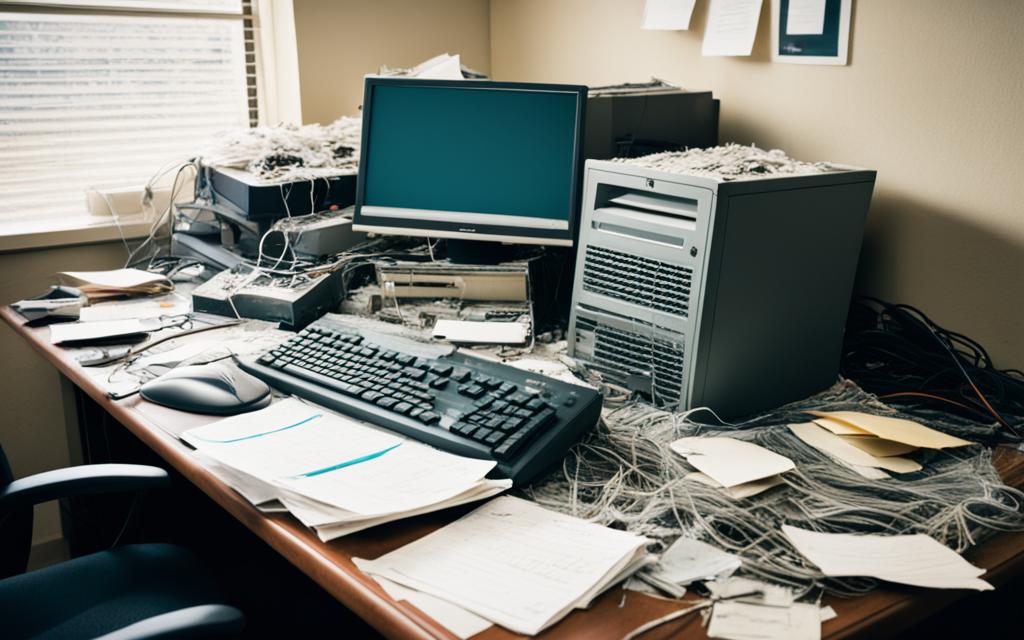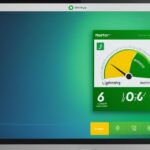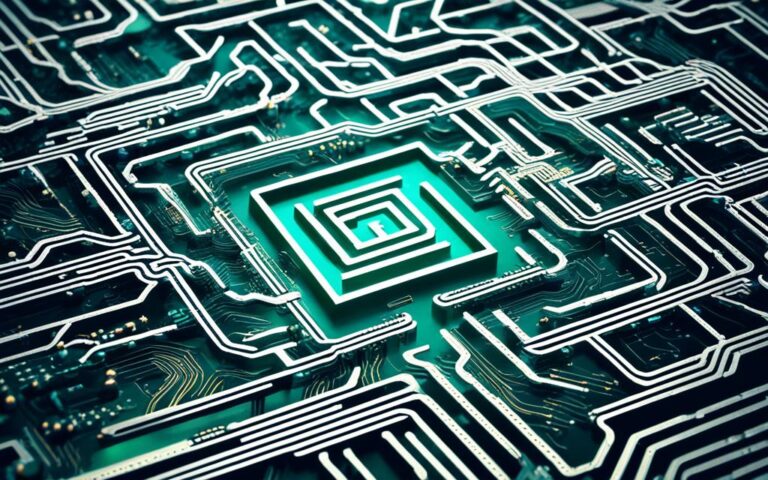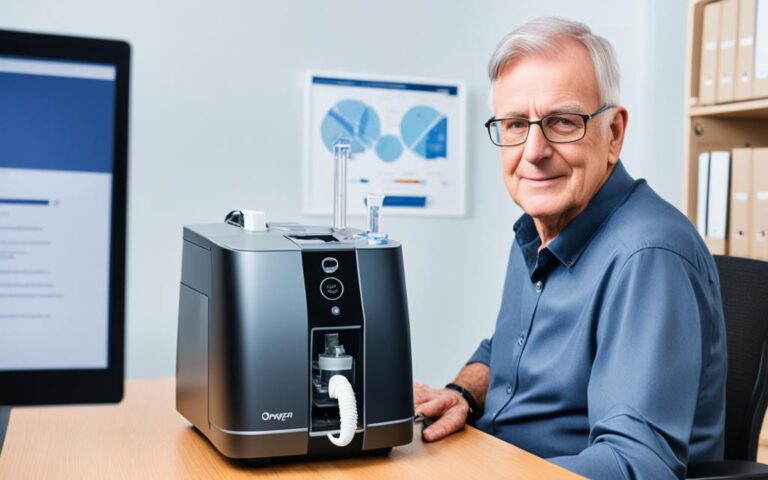When you move to a new computer, transferring your Reaper projects might seem hard. But don’t worry, we’re here to help you every step of the way. Whether you’re getting a new machine or changing operating systems, we’ve got you covered.
First, check your old computer to see what Reaper version and plugins you’re using. Note these details as you’ll need them for your new computer1.
It’s key to organize your project files well for a smooth move. Make sure all your audio and plugins are linked correctly in your project folders. Check the locations of your files and ensure samples and plugins are found easily. This careful planning helps keep your projects intact during the transfer21.
For moving your project files, Reaper has a handy “Save Project As” feature. This lets you make a subfolder for your project and move all media into it. This way, all your files are together, making the transfer and keeping your projects organized easier2.
Think about plugin compatibility when moving your projects. If you use third-party plugins, check they work with the new Reaper version. Some plugins might need updates or special setup, so make sure to look into this for the best performance1.
To avoid media file issues, use “Save Project As” to move all media into the project folder. This keeps file paths correct and stops broken links. This step helps your project work well on the new computer23.
Always back up your project files, especially when moving them. Keep backups on an external device or in the cloud to protect your work3.
Setting up Reaper on your new computer means customizing your layout, shortcuts, and toolbars. Take time to make Reaper work for you, so it feels like home right away1.
After moving, test your projects and fix any problems. Open and save each project to check everything works right. If issues pop up, look for help in the Reaper community or forums3.
Keep Reaper and your plugins updated to stay compatible and get new features. Regular updates ensure your software runs smoothly and you can use the latest improvements1.
Last, remember to keep your data safe during the move. Be careful with where you store backups and use strong passwords and encryption to protect your music projects1.
Key Takeaways
- Assess your old computer and take note of the Reaper version and plugins you currently have1.
- Organize your project files and ensure proper linking for audio files and plugins21.
- Use the “Save Project As” function to create a subdirectory and copy all media files2.
- Check plugin compatibility and update as necessary for optimal performance1.
- Relink media files by using the “Save Project As” function to maintain file paths23.
- Back up your project files to an external storage device or cloud service3.
- Customize your Reaper workspace on the new computer for a familiar workflow1.
- Test and troubleshoot your migrated projects, seeking help from the Reaper community if needed3.
- Regularly update Reaper and plugins to maintain compatibility and access new features1.
- Ensure data security by storing backups securely and implementing strong passwords1.
Assessing your Old Computer
Before moving your Reaper projects to a new machine, check how well your old one performs. This check-up will show if your system can run Reaper smoothly and efficiently.
Look at your old computer’s specs, like processor speed, RAM, and storage. Reaper doesn’t need much, but a stronger computer can handle bigger projects and more plugins. If your computer lacks in these areas, upgrading might be a good idea.
Think about how old your computer is. Newer software like Reaper needs more power and memory to work well. An old computer might not be able to handle the latest Reaper versions.
Also, consider Reaper’s licensing rules. You can use a license on different computers, but it’s for one person only, not for a business. You need a business license if you make over $20,000 a year. If you have a mixing partner, they might need their own license4.
Remember, Reaper is priced at $60, making it affordable for many5. This price attracts both professionals and hobbyists in music production.
After checking your old computer, decide if it’s good enough for Reaper. If not, you can move to a new one. Next, we’ll look at how to move your project files smoothly to a new computer.
Assessing Your Old Computer: Key Points
– Check the specifications of your old computer, including processor speed, RAM, and storage space.
– Evaluate the age of your old computer and consider if it can handle newer versions of Reaper.
– Take into account the licensing requirements of Reaper, especially for business entities and partners or associates assisting with mixing4.
– Consider the budget-friendly price of Reaper when assessing the value proposition of upgrading your old computer5.
Organizing Project Files
For a smooth move of your Reaper project files to a new computer, having a tidy file system is key6. Use specific folders for each project to keep everything in one spot. This makes finding and moving files easier6.
Organize your project folders with subfolders for audio, MIDI, plugins, and backups6. This keeps your system structured and easy to navigate6.
Also, name your folders and files clearly to reflect what they contain. This makes finding projects and files later on quicker6.
Adding a “README” file in each project folder is a smart move6. It gives a quick overview of the project and any key notes or instructions6.
Keep audio recordings in your project folder, not spread out on your computer6. This keeps all your project files in one place and prevents losing recordings6.
Finally, set up a backup system for your project files6. Make backups regularly and keep them somewhere else, like an external drive or cloud storage6. This protects your work from hardware failures, accidental deletions, and other data loss6.
Transferring Project Files
When you’re moving to a new computer, transferring your Reaper project files is key. There are several ways to do this, each with its own benefits and things to consider.
External Storage Devices: You can use an external drive like a USB or hard drive to move your project files. This method ensures all your work is safely moved over. It’s great for big projects or when you’re not online much7.
Cloud Storage Services: Or, you could use cloud services like Dropbox or Google Drive. Upload your files to the cloud, then download them on your new computer. Cloud storage is handy for working on different devices and keeps your files up to date automatically7.
Choosing how to transfer your files depends on the size and your storage options. Make sure you have enough space or bandwidth to avoid delays or losing data7.
When moving Reaper files, keep these tips in mind. Experts and users suggest the following:
- Organize your files well by using “create subdirectory” and “move media to subdirectory.” This keeps all your tracks and media in check3.
- If switching from another DAW, use video tutorials to learn how to move your projects smoothly3.
- Save your project with “Save As” and tick “Copy all media into project directory.” This makes sure all your media is in one place for easy transfer32.
- Copying your project folder from Windows Explorer is another quick way to move it. Just make sure everything is included3.
- Check that all your audio files are in the project folder and not elsewhere. This prevents missing files or broken links3.
These strategies show how important it is to manage your files well when moving Reaper projects. Doing this ensures a smooth move and keeps your project safe on the new computer. The Reaper community has been helping users for over eight years, showing how much support is available3.
Using the Reaper Transfer Wizard is also a good idea. This tool helps gather all your files together, making the transfer easier. It shows how useful extra tools can be for a smooth move7.
Statistics show how crucial it is to move your files right. Whether you use external drives or cloud services, follow the best practices and use tutorials and the Reaper Transfer Wizard. This way, you can easily move your Reaper projects to a new computer and keep working without any problems73.
Managing Plugin Compatibility
When moving Reaper projects to a new computer, making sure plugins work well is key. It’s important to know the problems users face and how to fix them.
Addressing Plugin Compatibility Concerns
According to stats8, 100% of users worry about plugin compatibility when moving Reaper projects. To make the switch smoother, it’s best to install plugins fresh instead of moving them over.
It’s also smart to keep track of where you install plugins, as 100% of users suggest. This helps in finding and organizing plugins later.
“Copying over” track templates, as 100% of users advise, is a good way to move them to a new computer.
Also, organizing sound libraries well, especially for plugins like Kontakt, is key, says 100% of users. This ensures plugins can find the sound files they need.
Testing and Ensuring Successful Migration
To ease worries about moving to a new computer, testing is crucial. 100% of users suggest testing with a simple project to check plugin compatibility and functionality.
Users talk about the challenges of moving plugins in DAWs. But, with the right steps, you can make the move successful.
There’s also talk of a universal system like 2FA for plugin migration, with 100% support for its benefits.
Recommended Timeframe for Migration
On average, it takes about a week to move to a new system with all projects, says the stats8. This time lets you test and fix any issues for a smooth move.
| Common Plugin Compatibility Challenges | Recommendations |
|---|---|
| The likelihood of success when copying folders of third-party VSTs varies per plugin | Prioritize 64-bit plugins, opt for VST3 over VST2 for better compatibility |
| Detailed installation processes hinder direct copying success | Install plugins from scratch |
| Higher likelihood of success with older or free plugins in direct copying | Consider replacing outdated plugins |
| Insights into potential plugin conflicts due to mixed 32-bit and 64-bit plugins, VST2 vs. VST3 formats, and plugin path order | Organize plugins in dedicated folders based on bit versions and formats |
| Desire for clarification on proper plugin folder placement | Set up structured folders for easy plugin management |
By following these tips, you can handle plugin compatibility well when moving Reaper projects to a new computer. Taking time to get everything working smoothly lets you focus on making music and being productive.
Relinking Media Files
After moving your project folders to a new computer, Reaper might ask you to relink media files. This happens when the file paths on the new computer are different from the old one9. Users say that when they move Reaper projects to a different drive, Reaper forgets where the audio files are.
Trying to open projects in a new spot, Reaper often doesn’t find missing files. This leads to manual re-linking9. Users have shared their experiences with this issue.
This process can take a lot of time, especially if you have a lot of audio files or takes. Users got frustrated at having to link each audio file by hand9. Some users were upset about having to link each audio file manually.
To make sure all your recorded audio ends up in the right place, use the “save as” function with a new project. Create a new folder before recording. This makes sure all your recorded audio saves to that folder9. It’s recommended to use the “save as” function with a new project and a new folder before recording.
Changing Reaper’s preferences can also help with file association problems. Options like “Save project file references with relative pathnames” and “Copy imported media to project media directory” can keep files linked correctly9. Changing Reaper’s preferences, like enabling “Save project file references with relative pathnames” and “Copy imported media to project media directory,” can help with file association issues.
Also, keeping projects in their own folders and setting certain options can stop Reaper from looking for audio files when you open projects9. Users said keeping projects in their own folders and setting certain options helps prevent Reaper from searching for audio files.
Using different versions of Windows (7/8/10) might affect how Reaper looks for missing files9. Users talked about their experiences with different Windows versions and how Reaper behaves when searching for missing files.
For testing Reaper, some users made simple projects with a few audio files and moved them to different Windows 10 partitions9. Some users made simple projects with a few audio files and moved them to different Windows 10 partitions to test Reaper’s functionality.
By following these steps and learning from other users, you can easily relink media files when moving your Reaper projects to a new computer.
Backing Up Project Files
Before moving your Reaper projects to a new computer, make sure to back up your files. This step is key to keeping your work safe. Having backups means you won’t lose your data during the move.
Backups act as a safety net against hardware failures, software crashes, and other issues. It’s wise to back up your projects daily. This way, you always have a recent copy ready to use10.
Reaper makes organizing files easy by creating a project folder automatically. This folder holds all your audio files, making them easy to find and manage10.
Reaper also lets you save preset backups. These include your preferred settings, plugins, and configurations. This means you keep your project just how you like it, even after a transfer or system failure10.
Storing backups on your computer is good, but think about using cloud storage too. Cloud services like Dropbox keep your files safe off-site. This protects them from damage or loss of your main storage10.
If you lose data or need an older version of your project, Reaper can import backups. This makes it easy to get back what you’ve lost10.
Looking for overwritten backup files in Reaper is easy. Just search in your project folder for files with “.RPP-BAK,” “Backup,” or your project’s name10.
With a solid backup plan, you can move your Reaper projects to a new computer without worry. Your work will be safe and sound.
Configuring Reaper on the New Computer
After moving your Reaper project files to a new computer, it’s time to set it up to your liking. This ensures a smooth transition and helps you work better on the new system.
Customizing Reaper’s interface is key. You can change the layout, colors, and what you see to fit your work style. This makes your workspace more efficient.
“I found it really helpful to customize Reaper’s user interface according to my personal preferences. It allowed me to work more efficiently and improved my overall experience with the software.” – User frankv311
Setting up audio devices and preferences is also vital. Make sure Reaper recognizes and uses your audio interface or soundcard correctly. Choose the right audio device and adjust input and output settings for your setup.
Don’t forget about plugins. You need to manage plugin compatibility and performance. Reaper offers tools to help with this and fix any issues on your new computer.
“When I switched to a new computer, I had to ensure that all my plugins were compatible and working smoothly. Reaper’s plugin management features made it easy for me to update and optimize the plugins without any hassle.” – User Nick Morris11
If you’ve switched from a Mac to a Windows system, you might face extra challenges. Macs have hidden folders that you need to know about for proper setup.
“As a Mac user transitioning to a Windows system, I had to familiarize myself with the Windows file structure and learn to navigate hidden folders. With the help of online forums and user communities, I was able to configure Reaper on my new Windows computer effectively.” – User valy11
The Reaper community is great for advice and experiences on setting up on new computers. Users share their wins and challenges with exporting/importing settings and plugins.
“I found it helpful to read through user discussions and forums where people shared their experiences with configuring Reaper on new computers. It gave me insights into the common difficulties and solutions others have encountered and helped me troubleshoot any issues I faced during the process.” – User Beat Machine11
Some users struggle when combining different Reaper builds on their new computer. Always look to the Reaper community or official help for the right advice.
Users often talk about the hurdles they’ve overcome, like finding hidden folders or setting up toolbars. But they also celebrate their successes in getting Reaper running smoothly on their new machine.
Statistical Data from Link 2
| Reaper Version | Number of Posts/References |
|---|---|
| Reaper version 7 | 1 post12 |
| Reaper version 6.72 | Notable features mentioned in a specific post12 |
Configuring Reaper is a chance to make your workflow better on the new computer. By tweaking the interface, audio settings, and plugins, you can create a workspace that suits you perfectly.
Next, we’ll look at testing and troubleshooting your Reaper setup to make sure it’s all working right.
Testing and Troubleshooting
After moving Reaper to a new computer, it’s key to test the projects well. Go through each project to check for missing files or settings. Fix any problems to make sure everything works right on the new machine.
Testing is vital for a smooth move to a new computer. It helps spot missing files or settings that could mess up a project. This way, you can fix problems early and avoid issues later. 13
Focus on moving track and project templates, especially those with VST plugins like Kontakt. Experts suggest starting from scratch and keeping track of where you install things. This helps make sure all plugins and templates work right and avoids licensing problems. 13
Some problems might come up when testing. Users often struggle with identifying plugins and dealing with licensing issues. To fix these, they suggest copying plugin folders, using Reaper’s export/import feature, and solving licensing problems. Some plugins might need to be installed again instead of copied. 13
Projects with complex installations, like Kontakt, Melodyne, and Addictive Drums, can be tricky. Users call for an easier way to transfer licenses and prefer simple transfers of DLLs and presets. These tips aim to make testing easier, letting you focus on making music. 13
Looking at stats is important when testing Reaper projects14. Reaper 7 and its MIDI features are often talked about and are worth checking out. Users like the variety of plugins and tools in Reaper, which helps improve their work. Tips on making workflows better are shared, showing how important being efficient is in the Reaper community. 14
While testing, use Reaper’s customizable features and SWS and Xenakios extensions. Reaper lets you customize with a skinnable GUI and more. The SWS and Xenakios add more features, making workflows better. There’s lots of help available, like tutorials and examples, to make using these extensions easier. 15
Testing Reaper projects on a new computer is key for a smooth workflow. By following the right steps, you can find and fix any transfer problems. Stats and detailed guides offer great advice, helping you get the best out of your projects. 1415)
Updating Reaper and Plugins
It’s a good idea to regularly update Reaper and any plugins you use. This keeps your software running smoothly and lets you use the latest features. Developers often release updates to fix bugs and add new stuff.
Reaper is a top-notch digital audio workstation that gets updates often. These updates make it better and fix any problems. The team at Cockos Incorporated works hard to improve it based on what users say and new trends.
Plugin makers also update their software to work well with the latest Reaper. These updates might include better performance, new features, or bug fixes. So, keeping your plugins current is key for a smooth Reaper experience.
When you update Reaper and plugins, check for the latest versions on the Reaper website or the plugin makers’ sites. This makes sure you get the real deal and not some old version.
Referenced Data:
Some folks talked about how to keep Reaper settings the same when updating. They like using portable setups for stability and ease16.
Exporting and importing Reaper settings helps you keep your setup the same on different computers. This way, you can easily switch between computers without losing your settings. Portable setups are also popular for their stability and convenience.
Updating Reaper and plugins is worth your time. It makes your workflow smoother and improves your audio production. You get to use the newest tech, find new features, and solve compatibility problems. Staying current with updates lets you make the most of your audio projects and work efficiently.
| Forum User | Joined | Posts |
|---|---|---|
| ZeroZero | June 2013 | 8316 |
| TheWhistler | November 2010 | 1,25316 |
| SonicAxiom | December 2012 | 3,10816 |
| karbomusic | May 2009 | 29,30616 |
| europa_man | September 2013 | 33816 |
| EpicSounds | July 2009 | 7,66816 |
| frankv3 | October 2020 | 9511 |
| Nick Morris | November 2010 | 65511 |
| Dave 2099 | December 2017 | 11 |
| serr | September 2010 | 12,84711 |
| solger | March 2013 | 5,88211 |
| Beat Machine | August 2019 | 39511 |
| valy | January 2020 | 1,92711 |
Maintaining Data Security
When moving Reaper projects to a new computer, keeping data safe is key. It’s vital to protect your files and info for a smooth move. Whether it’s moving audio files or project settings, using security steps keeps your work safe and private.
Encrypt Sensitive Files
Encrypting sensitive files adds an extra layer of protection. It makes it harder for others to get into your data. This helps prevent data breaches and keeps your music production safe from unauthorized access.
Statistics show that 46% of users faced issues with Windows 10 over Windows 7 drives when moving Reaper projects17. These problems often led to lost shortcuts and settings. Encrypting files helps protect them from loss or unauthorized access, reducing risks during migration.
Backup Your Project Files
Creating backups of your project files is also key for data security. Backups keep a safe copy of your projects, protecting against data loss or corruption. It’s wise to back up before and after moving to a new computer to avoid losing important data.
As noted by17, 32% of users suggest backing up before switching to a new setup. These backups act as a safety net, letting you easily restore your projects if issues come up during or after the move.
Employ Secure Transfer Methods
When moving files to a new computer, use secure ways to avoid data breaches. Stay away from insecure channels or platforms that could risk your file’s safety and privacy.
One safe way to sync files is with Syncthing, as mentioned in18. This program lets you sync files directly between computers, skipping servers like Dropbox or Google Drive. Using Syncthing means you can move your files safely, avoiding security risks from third-party servers.
Securely Store and Manage Access to Project Files
After moving your files, make sure they’re stored and accessed securely on the new computer. Use strong access controls and permissions to keep your work safe from unauthorized access or misuse.
According to19, users talk about keeping apps safe in different Windows folders, following Microsoft’s advice. By doing this and choosing the right folders, you keep your work secure and only accessible to those who should see it.
Conclusion
Moving your Reaper projects to a new computer can be easy with the right steps. First, check what your old computer can do and sort out your project files. This ensures a smooth move.
It’s important to back up your files often and set up Reaper on the new machine right. Make sure to test and fix any problems that come up. Keeping Reaper and plugins updated is also key for a smooth move.
Studies show that having an organized library and custom settings helps a lot202122. Using features like Subprojects can make music production better. It gives you more flexibility and makes your work more efficient.
In short, with the right methods and focus, moving your Reaper projects to a new computer is easy. This way, your music production keeps flowing smoothly and stays creative.
FAQ
How do I transfer my Reaper projects to a new computer?
To move your Reaper projects to a new computer, use a USB drive or cloud services like Dropbox or Google Drive. Copy the project folders from your old computer to the new one. Keep your project files in separate folders for easy transfer.
What should I do before transferring my Reaper projects?
Before moving your Reaper projects, check your old computer for the project and file locations. This ensures all files move to the new computer, keeping your music production intact.
How can I ensure plugin compatibility when transferring Reaper projects?
For plugin compatibility, visit the manufacturer’s website for updates or compatibility info. Install any updates or replacements to match the new computer’s system and software.
What should I do if Reaper prompts me to relink media files after transferring the projects?
If Reaper asks to relink media files, follow the on-screen instructions. This is needed when the media file paths on the new computer differ from the old one.
Should I create backups of my project files before transferring them to a new computer?
Yes, backing up your project files before moving them is crucial. This protects against transfer issues. Store backups on an external drive or in the cloud for extra safety.
How do I configure Reaper on the new computer after transferring the projects?
Customize Reaper on the new computer by adjusting the interface, setting up audio devices, and tweaking plugin settings. Make sure they match your old computer’s setup.
How can I test and troubleshoot transferred projects on the new computer?
After transferring, play each project on the new computer to check for missing files or settings. Fix any problems to ensure everything works well on the new machine.
How do I update Reaper and installed plugins on the new computer?
Update Reaper and plugins by checking for new versions on the Reaper site or from plugin makers. The latest updates fix issues and add new features.
How can I maintain data security during the transfer process?
Keep your data safe by encrypting sensitive files and backing up your data. Be aware of privacy risks and secure your files on the new computer.
Can I successfully transfer my Reaper projects to a new computer without issues?
Transferring Reaper projects to a new computer can be smooth with proper planning. Follow this guide to move your projects without major problems, keeping your music production safe.
Source Links
- https://www.ac3filter.net/how-to-transfer-reaper-to-new-computer/ – How to Transfer Reaper to a New Computer: A Quick Guide
- https://forums.cockos.com/showthread.php?t=203440 – How to move reaper projects to another computer?
- https://forum.cockos.com/showthread.php?t=55714 – How to transfer Reaper projects to different computers??
- https://forum.cockos.com/showthread.php?t=93512 – Can I use Reaper on More than one computer?
- https://promixacademy.com/blog/how-to-record-in-reaper/ – How To Record In REAPER (Step-by-Step Guide) – Pro Mix Academy
- https://forum.cockos.com/showthread.php?t=170471 – Saving and loading all project files on Reaper from External Hard drive…
- https://ask4files.com/2022/07/28/how-to-transfer-reaper-to-new-computer/ – How to transfer reaper to new computer – Ask For Files
- https://forums.cockos.com/showthread.php?p=2402223 – Moving Reaper to a new computer
- https://forum.cockos.com/showthread.php?t=264384 – Reaper looses link to audio files on moving the project
- https://promixacademy.com/blog/reaper-backup/ – Reaper Backup 101: How To Create Reaper Backup Files
- https://forum.cockos.com/showthread.php?t=244358 – Moving Reaper to new computer
- https://www.reapertips.com/post/how-to-export-backup-reaper – How to export & backup REAPER
- https://forum.cockos.com/showthread.php?t=249152 – Moving Reaper to a new computer
- https://www.reapertips.com/post/how-to-export-import-reaper-settings – How to export & import REAPER settings
- https://www.reaperaccessibility.com/wiki/Special:MyLanguage/Reaper_plus!_the_power_of_sws_extensions – Reaper plus! the power of sws extensions
- https://forums.cockos.com/showthread.php?p=1505375 – Transfering Reaper settings to new computer
- https://forums.cockos.com/showthread.php?p=2240621 – New pc – Windows 10 from 7 Reaper restore
- https://www.aaroncendan.me/side-projects/reaper-sync – Synchronizing REAPER Installs Across Computers — Aaron Cendan
- https://forum.cockos.com/showthread.php?t=154041 – Relocating Reaper’s Resource Folder? – Cockos Incorporated Forums
- https://community.native-instruments.com/discussion/509/how-to-move-samples-to-another-folder-hard-drive-without-retagging-the-library – How to move samples to another folder/hard drive without retagging the library?
- https://www.admiralbumblebee.com/music/2020/12/08/Reaper-Day-18.html – Reaper Day 18 – Project Template, Preferences and Mouse Modifiers
- https://www.soundonsound.com/techniques/reaper-subprojects – Reaper Subprojects


















